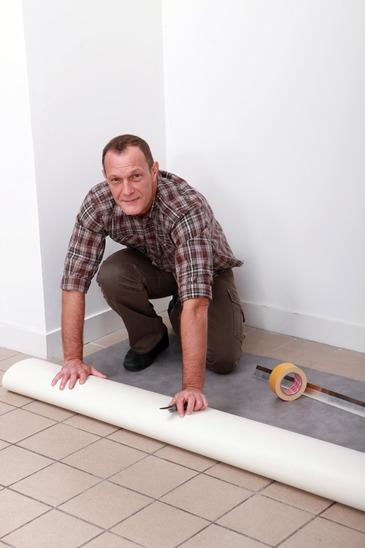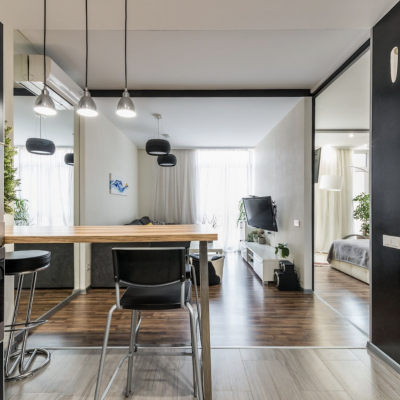Many people think vinyl flooring in Portland is just about extinct. With the increased popularity of hardwoods, laminates and tiles, who in their right mind would buy sheet vinyl?
You might be surprised to hear that the vinyl flooring industry is alive and well. In fact, Vinyl flooring in Portland is the preferred choice for many customers. There are even customers that will have nothing but sheet vinyl in their homes. How can this be? In the big picture of things, it’s not that surprising. Vinyl has a very important role in home interiors and it’s not going away anytime soon. If you think about practical living, this floor would represent it better than anything.
Let’s face it, many people associate vinyl flooring with a cheap apartment. They visualize an ugly, old pattern with a seam down the middle of the kitchen. Maybe they envision it coming apart and being lifted off the floor. There are even gouge marks scattered about the floor that reveals the subfloor underneath. There are circular ring stains in the corner of the floor where a planter once sat. You can see the traffic patterns in the floor because the main traffic areas have been worn down so much that you see the white backing thru it. Not appealing by any means; an eyesore in fact.
So what could possibly be good about a Vinyl flooring?
The Benefits of Vinyl Flooring
For one, if you’re on a budget, nothing can get close to the price of a Sheet Vinyl floor. Plus, if you want to install it yourself, it’s ten times easier and faster to install than anything else.
If you have an excess of water in your house (either from humidity or from the various kitchens, bathrooms, etc.), nothing is safer to leave water on than Vinyl. In terms of care, short of a concrete floor, vinyl is the easiest to take care of.
And, if you have pets (or rambunctious toddlers) that traipse through the mud outside and come indoors, then vinyl is the easiest to clean. The maintenance on hardwood, tile or laminate is at least five times more than vinyl; with the former options, you need to clean the groves, the grout in between – it’s a hassle and most people prefer the choice that’s less work.
Vinyl Flooring Throughout History
Since the beginning, vinyl has come in a variety of qualities. Over the years, there has been an evolution of thicknesses, styles and manufacturing processes. The entry level quality was and still is the super thin stuff most contractors put in cheaper apartments (and homes). This type of vinyl is easy to tear or gouge and usually has a design of some type printed on a thin backing.
Of course, for some industry background, the king of vinyl flooring historically was Armstrong, Designer Solarian. This was some vinyl flooring unlike any other. It was much thicker and made by melting tiny granules together to form a pattern. It was extremely heavy and only came in 6’ widths because 12’ would be too heavy for an installer to manage. Only Armstrong made it because they invented it and held the patent. They used the term “Inlaid” to describe that the color went all the way through to the back. If you gouged it, you wouldn’t see a white backing because there wasn’t one. They literally had a monopoly on the high end vinyl flooring industry for decades.
That said, the price of Solarian floors kept going up and the heavily patterned designs started fading in popularity. And then, a new product called laminate flooring started showing up in showrooms.
The Rise of Laminate
Laminate was a piece of Formica put on a board and then laid on a floor. Prior to this, Formica was only put on countertops. Several companies in Europe had started making these floors and consumers loved them.
The heavy vinyls that people had been putting on their floors for decades started sitting in dealers’ showrooms for longer and longer periods. Consumers started saying no to $50 per yard for vinyl and many started choosing laminate flooring instead and this caused the entire vinyl industry to go through a major shakeup. In the end, the biggest and most successful vinyl manufacturer, Armstrong, was in financial trouble and discontinued his all-time biggest selling vinyl line, Designer Solarian. The stencils and plastic granules they invented to make these floors for decades would be retired forever.
During the late 90’s, the laminate flooring industry continued to grow at the expense of the vinyl manufacturers who were trying to find their place. Then, someone in the vinyl industry figured out a way to make vinyl with a fiberglass backing and that changed everything.
There were a couple of big drawbacks that consumers did not like about vinyl and this breakthrough changed all of that.
1. Vinyl cut or gouged too easily and this made it less valuable to consumers.
2. There were huge amounts of floor preparation that went into laying a vinyl floor, driving the price of installation up considerably.
Fiberglass backed vinyl solved both these problems. For one, it was much harder to tear, but secondly almost no prep was needed to lay it down. This revolution would bridge over most subfloor irregularities and it didn’t even need to be glued, it could just be stapled around the walls. This was a game changer for vinyl (and as an added bonus, the new backing wasn’t expensive).
The Return of Vinyl Flooring
The vinyl industry came back with a roar and all the major manufacturers overhauled their lines. They still made the paper thin vinyl, but they made improvements to it. Their primary focus was the medium to higher priced quality flooring. Their goal was to build beautiful floors that could take a beating and not cost consumers an arm and a leg.
The very top end floors (the $50 ones mentioned earlier) never came back and never will. They realized there would be a new price threshold for vinyl flooring and settled on price points between $8 and $35 per square yard. There were also many fewer 6’ wide choices too. Consumers don’t want seams unless they need to have them so they focused on 12’ widths.
The popularity of vinyl has come back but may never be the primary flooring for kitchens and baths like it used to. Consumers will usually have vinyl somewhere in their homes but it won’t be showcased the way it was 20 years ago. This evolution has been good for the consumers, however. The overhaul the industry went through lowered prices tremendously on all vinyl floors. It also improved the overall quality of the backings as well as the wearing and cleaning features. Many homes have rooms that need a floor but doesn’t get much attention. When the vinyl manufacturers redesigned their lines, many were introduced with little to no pattern at all. The fact that Vinyl is so easy to take care of and so water proof makes it a great choice for mud rooms, utilities, bathrooms, and so on. There’s no way that hardwood and/or laminates will ever be able to replace them.
Guest Post by:
Carpet Carl is the owner of Marion’s Carpet Warehouses, Oregon’s largest flooring retailer. He has spent 40 years in the flooring business and is among the country’s top consultants in product development. He contributes to articles in the National Floorcovering Magazines regularly and networks with the country’s top flooring dealers.




